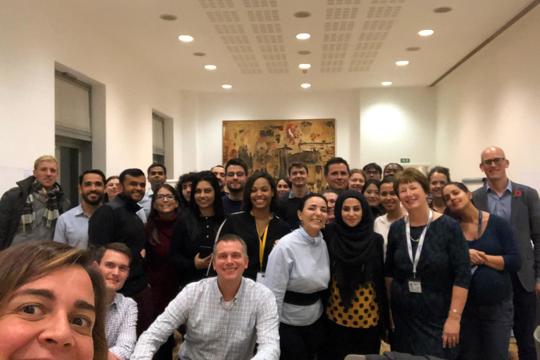
How to decide if it's time to adapt your business model
In this article, you'll learn to avoid the "Blockbuster moment" by embracing changing customer needs and adapting your business model to stay relevant and competitive.
You’ll learn:
-
Why staying close to customer expectations is critical for long-term success.
-
How to identify outdated business practices that need to be eliminated.
-
How to use the Blue Ocean Strategy’s four powerful questions to rethink your business and create a competitive advantage.
A practical way to kickstart re-invention.
Every business reaches a critical moment where it must decide: adapt to changing customer expectations, or risk becoming irrelevant. This is often referred to as the "Blockbuster moment"—a reference to the once-dominant video rental chain that failed to see the rise of streaming services like Netflix. Blockbuster’s failure to evolve in response to changing consumer behavior led to its downfall.
But there’s another path. Think of Cirque du Soleil, which faced a similar crossroads in the 1980s. Traditional circuses were losing popularity, with customers growing weary of animal shows and standard circus acts. Instead of sticking to the old formula, Cirque du Soleil reimagined the circus, creating a new kind of entertainment experience that became wildly successful and radically more profitable.
If you want your business to stay competitive, you need to constantly reassess how well you’re meeting the needs and expectations of your customers. In today’s rapidly evolving marketplace, customer-obsession and continuous innovation are key to staying relevant.
The Risk of Facing a “Blockbuster Moment”
Many companies fall into the trap of clinging to business models and practices that worked in the past, without noticing that their customers' expectations are shifting. The result is often devastating, as the company finds itself struggling to compete with more nimble competitors who have adapted to the new market reality.
Blockbuster is a classic example. At its peak, Blockbuster was the leader in video rentals, with thousands of stores worldwide. However, when customers started shifting to streaming services and on-demand video, Blockbuster stuck with its physical store model. Netflix, a small competitor at the time, embraced streaming and ultimately revolutionized the way people consumed content.
Blockbuster’s failure to adapt to customer preferences sealed its fate, while Netflix thrived by recognizing and catering to a new generation of consumers.
The key lesson here is clear: if you’re not willing to challenge your own business model and adapt to changing customer needs, you risk losing relevance in the market. This is where the concept of a Cirque du Soleil moment comes in—an opportunity to reinvent your business model and stay ahead of the curve.
How Cirque du Soleil Seized Its “Blue Ocean” Opportunity
Back in the 1980s, circuses were facing a major decline. Animal rights concerns were growing, and customers were losing interest in traditional circus acts. Cirque du Soleil saw this shift as an opportunity to reinvent the circus—and in doing so, they not only revived the industry, but also created a unique, high-value product that appealed to a whole new audience.
Cirque du Soleil’s success was guided by the Blue Ocean Strategy, a business framework that helps companies identify opportunities for growth by creating new markets rather than competing in saturated ones. Instead of trying to compete with traditional circuses on their terms, Cirque du Soleil redefined the experience by removing costly elements like animal shows and star performers, and adding elements of theater, dance, and music to create a more sophisticated and emotionally engaging performance.
Their approach helped them appeal to both circus-goers and theater enthusiasts, allowing them to charge much higher ticket prices and attract a completely different demographic.
Using the Blue Ocean Strategy to Reinvent Your Business
To identify your own “Cirque du Soleil” opportunity, you can apply the Blue Ocean Strategy’s four powerful questions. These questions help you rethink your business model and discover where you can create new value for your customers while eliminating outdated practices.
1. What factors can we eliminate?
The first step is to identify elements of your business model that no longer provide value to your customers. These are features or offerings that are outdated, inefficient, or irrelevant in the current marketplace. By eliminating them, you can reduce costs and refocus your resources on what matters most to your customers.
Example: Cirque du Soleil eliminated animal shows, which had become unpopular due to growing concerns about animal rights. By removing this costly and controversial element, they not only reduced their overhead but also aligned themselves with shifting consumer values.
Your Turn: Think about your business. Are there outdated services, features, or processes that no longer add value to your customers? What can you eliminate to streamline your business and better meet modern expectations?
2. What factors can we reduce?
Next, identify areas where you can reduce your focus or investment. These are factors that may still provide some value to your customers but are no longer as important as they once were. By reducing your investment in these areas, you can redirect resources to higher-value opportunities.
Example: Cirque du Soleil reduced the emphasis on humor and thrills, which were staples of traditional circuses. Instead, they focused on creating a more elegant, theatrical experience.
Your Turn: Are there parts of your business that were once important but are now less relevant? Could you scale back on these elements to focus on something more meaningful to your customers?
3. What factors can we raise?
This question asks you to identify areas where you can raise the standard and provide more value than your competitors. These are the aspects of your business that truly matter to your customers and can differentiate you in the marketplace.
Example: Cirque du Soleil raised the standard for venue design and production quality, creating an immersive experience that felt more like a high-end theater production than a traditional circus.
Your Turn: What are the key elements of your product or service that your customers care about the most? How can you improve or enhance these areas to deliver a superior experience?
4. What factors can we introduce?
Finally, think about what new factors you can introduce to your business model that will set you apart from the competition and meet the evolving needs of your customers. These are the innovative features or services that no one else in your industry is offering.
Example: Cirque du Soleil introduced elements of theater, dance, and live music, transforming the circus into a sophisticated art form that appealed to adults and families alike.
Your Turn: What new features or experiences could you introduce that would create additional value for your customers and give you a competitive edge?
How to Stay Close to Changing Customer Expectations
Understanding what your customers need and expect is the key to staying relevant. However, customer expectations are not static—they evolve over time, and it’s your job to keep up. Here are some practical strategies to ensure you’re staying close to your customers and adapting to their changing needs:
1. Regularly Gather Customer Feedback
To stay ahead of customer expectations, you need to make feedback a regular part of your business. Use surveys, focus groups, or customer interviews to ask specific questions about what they value, what they want more of, and what they can do without.
-
What features or services do they find most valuable?
-
What frustrates them about your current offering?
-
What new products or features would they like to see?
2. Observe Market Trends and Competitor Behavior
While direct customer feedback is critical, you also need to keep an eye on broader market trends and competitor behavior. Are your competitors introducing new products, services, or technologies that are reshaping customer expectations? Are there shifts in your industry that are creating new opportunities or threats?
By staying informed about what’s happening in the market, you can proactively adapt your business model rather than reactively playing catch-up.
3. Stay Flexible and Experiment
To remain competitive, your business needs to be flexible enough to adapt to changes quickly. Encourage a culture of experimentation within your team, where trying new approaches and making iterative improvements is part of your strategy.
This could mean piloting a new service, running A/B tests on different product features, or experimenting with different marketing strategies to see what resonates with your customers.
How you can start applying these ideas
Here’s some practical advice and thought-starter questions to help you stay relevant and seize your “Cirque du Soleil” moment:
1. Eliminate What No Longer Adds Value:
-
Advice: Take a hard look at your current business model and identify outdated services, features, or processes that no longer provide value to your customers.
-
Thought Starter: What parts of my business are no longer relevant to today’s customers? How can I streamline my offerings to focus on what matters most?
2. Raise the Bar in Key Areas:
-
Advice: Identify the areas of your business that truly matter to your customers and focus on raising the bar in those areas. This is where you can differentiate yourself and create a competitive advantage.
-
Thought Starter: What are my customers' top priorities, and how can I exceed their expectations in these areas?
3. Introduce New Features or Experiences:
-
Advice: Don’t be afraid to innovate. Introduce new features, services, or experiences that create additional value and help you stand out from the competition.
-
Thought Starter: What new elements can I introduce to my business that will set me apart from my competitors and appeal to evolving customer needs?
Wrap-up: challenge your board with these 4 questions to start turning the ship.
Staying relevant means more than just reacting to customer demands—it requires proactively adapting your business model to meet evolving expectations. By using the Blue Ocean Strategy’s four questions, you can identify outdated practices, refocus on what matters most, and introduce new elements that differentiate your brand.
Whether you’re eliminating irrelevant offerings or creating entirely new experiences, embracing change is the key to long-term success. Remember, it’s never too late to reinvent your business and seize your “Cirque du Soleil” moment.
RESEARCH BY SPRINT VALLEY
Ready to learn?
Discover what people really want (and wish you offered) with insights that shape what and how you sell.
